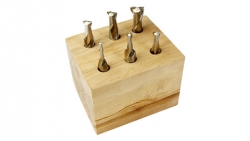Mini Mill ToolingEnd MillsConventional wisdom is that 2-flute end mills are used on aluminum, while 4-flute end mills are used on steel and brass. Take a look at why before you make a choice.
2-flute end mills are used on aluminum because aluminum is easy to machine and you can take big cuts. Two-flute end mills provide a lot of room between the flutes for the big chips produced when making heavy cuts. But on a mini mill, you are probably not as concerned about maximizing production, and thus you are not taking the same big cuts that a production shop might. 4-flute end mills can produce a slightly better finish at the same cutting speeds because there are twice as many cutting edges, each taking off half as much material. But again, if you are not trying to maximize production, you can simply slow the feed rate with a 2-flute end mill for the same effect. End mills are also classed as "center cutting" or "non center cutting". With a center cutting end mill, you can plunge the end mill into the work as you would a drill. This is important if you are cutting a slot that does not extend to the edge of the part. Center cutting end mills are easy to identify. If the flutes meet in the middle of the end of the end mill, it is a center cutting end mill. In some cases, one of the flutes will be longer, reaching right to the center. If the flutes stop short of the center, leaving a space with no flutes in the center, it is a non center cutting end mill. Virtually all 2-flute end mills are center cutting end mills. Currently, most 4-flute end mills are center cutting. All the end mills that LittleMachineShop.com sells are center cutting end mills. The 6-piece end mill sets we sell are economical starter sets. Because all the end mills in the set have 3/8" shanks, you only need one end mill holder or collet to use the entire set. End Mill Options
|



 Sensitive Drill Feed and 1/8" (3 mm) Keyless Drill Chuck
Sensitive Drill Feed and 1/8" (3 mm) Keyless Drill Chuck Tool Bit, 5/16" x 2-1/2", M2 HSS
Tool Bit, 5/16" x 2-1/2", M2 HSS
